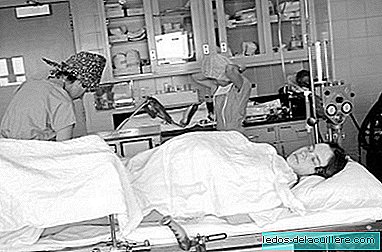
Some women have it very clear: they do it or they don't. But many women face the decision of whether to have an amniocentesis or not, and for all of us we are going to get a little closer to this prenatal test. These are ten questions about amniocentesis that will clear some doubts.
We will start by saying that the risk of having this invasive test exists and the data is known: about 1% of women who have an amniocentesis lose their baby. On the other hand, we can also say that the professionals who practice it are increasingly qualified and this test is crucial to detect many abnormalities in pregnancy.
The main criteria that are taken into account to recommend amniocentesis are a high risk result in the combined test of the first trimester of pregnancy (triple screening), family history or previous pregnancies with abnormalities, together with the advanced age of the pregnant woman .
- What is amniocentesis?
Amniocentesis is one of the invasive prenatal diagnostic techniques that are carried out in pregnant women to detect chromosonic and genetic defects of the fetus such as Down, Edwards or Turner syndrome, among others. It is performed around the 15th week of gestation and consists of the extraction of amniotic fluid (between 15 and 20 ml) by means of a puncture under ultrasound control in the mother's abdomen. This fluid contains desquamation cells of the membranes that surround the fetus and the fetus itself, which are grown for diagnostic tests.
Is it recommended for all women?
No, because as we have already advanced, it implies risks. Until a few years ago, in Spain the mother's age was used as a basic criterion to recommend amniocentesis (from 35 or 38 years old, according to the autonomous community), since at these ages the risk of chromosomal abnormalities rises so significant. However, today, it is possible to refine the calculation of the risk by age thanks to the markers that are obtained with different detection tests (biochemical test of maternal blood and ultrasound) and, with this, it is possible to avoid an important number of amniocentesis that always carry a risk.
These tests, called first quarter combined test, are now included in the prenatal diagnostic programs of the different health systems in the country and allow us to know with high reliability (85-90%) the risk of suffering from chromosomal abnormalities. In this way, health networks advise an invasive test such as amniocentesis only to pregnant women who obtain a combined test report with a high risk result (greater than or equal to 1 between 250-350, depending on the cut established by each autonomy ) and those with a history of previous or family pregnancies with abnormalities.
- When should it be done?
It can be done between weeks 14 and 20 of gestation. However, specialists recommend practicing it after week 15, since the risk of spontaneous abortion is higher if the test is performed during the first trimester of pregnancy.

Is amniocentesis a mandatory test?
No. Amniocentesis does not cure, it is offered to provide a diagnosis of certainty to pregnant women with a high risk in previous screening tests. Like the rest of the tests performed during pregnancy, it requires the informed consent of the pregnant woman.
- Does it involve any risk?
We have already mentioned in the introduction, the amniocentesis test is a safe technique, but it carries certain risks. The most prominent is spontaneous abortion after the test, which occurs in approximately 1% of cases. Other possible risks are fetal or cord puncture during the test, as well as infection or bleeding of the pregnant woman in the period after performing the technique.
- How long should the woman be at rest after having performed amniocentesis?
Doctors recommend that the pregnant woman stay in bed for about 48 hours. In this period it is convenient that you do not make any physical effort and remain calm and calm.
- What happens if there is a loss of amniotic fluid?
In the event that there is a loss of amniotic fluid, abortion does not always occur; The pregnant woman is hospitalized for control and is expected to recover.
When are the results of amniocentesis known?
In order to have an accurate and accurate diagnosis of the cells obtained through amniocentesis, it is necessary to keep them in culture for an approximate period of 14 days, so that the average waiting time from the extraction of the sample to the delivery of the final result ranges, in general, between three and four weeks.
However, to avoid the anxiety and concern of pregnant women during this long period, different protocols have been implanted rapid diagnostic techniques (FISH or QF-PCR) which, by not requiring a culture of the sample, allows obtaining a first result of the main chromosomal abnormalities in just 24 or 72 hours.
- What is the cost of the test?
Amniocentesis is included as a protocol test, and therefore free, in the public health network of Spain, both for pregnant women who have been diagnosed with high risk, and for those who claim anxiety about any abnormality. The latter profile is not systematically offered rapid diagnosis, since being a high-cost technique, risky pregnancies always have preference.
Most private insurance companies include amniocentesis among their benefits, without any age or risk limit, but in general they require an additional payment (between 150 and 250 euros) if they wish to obtain the previous results by rapid diagnostic techniques. In case of not doing it either for social security, or by insurance company, the price of the test is around 700-800 euros, plus a supplement of 150-300 euros for the rapid diagnosis.
- Are there other alternative techniques for early diagnosis?
In addition to amniocentesis, the invasive early diagnosis technique that is most frequently proposed to pregnant women is chorion biopsy. It consists of obtaining chorial villi of the developing placenta and is performed by abdominal or vaginal puncture, depending on the week of gestation and the position of the placenta. It can be done from the tenth week of pregnancy and, therefore, if the results of the first trimester screening have been negative, it is not necessary to wait until week 15 as in amniocentesis. The result is obtained in 24-48 hours and also implies an estimated risk of abortion between 1% and 2%.
There are investigations that ensure that 90% of the baby's anomalies are detected without amniocentesis, through ultrasound and diagnostic tests such as triple screening can identify the most common fetal pathologies such as Down syndrome, spina bifida, fetal heart disease or diaphragm hernias.
We hope you are ten questions (and their answers) about amniocentesis they have helped you to know more about this prenatal test, its risks and its usefulness, to decide whether to undergo it or not.












